Google Ads have historically stood at the pinnacle of digital advertising, offering endless possibilities for reaching one’s target audience.
Within the last couple of years, a new format has been born that seems to rewrite all the rules: Responsive Search Ads.
If you’ve been running traditional search ads, it’s time to think about how this game-changing approach takes your marketing strategy to the next level.
Responsive Search Ads allow you to create multiple headlines and descriptions, which Google will test through its automatic rotation and optimization to show users the best-performing ad combinations.
In this post, we will cover everything you need to know about Responsive Search Ads and how they will revolutionize your ad campaigns.
Let’s dive into what Responsive Search Ads are, how they work, and why you should start using them in your Google Ads strategy.
- What Are Responsive Search Ads in Google Ads?
- The Benefits of Responsive Search Ads
- How to Write Effective Responsive Search Ads
- Challenges and Limitations of Responsive Search Ads
- The Future of Responsive Search Ads in Digital Marketing
- Impact of Responsive Search Ads on Modern Advertising
- Responsiveness to Questions About Responsive Search Ads
What Are Responsive Search Ads in Google Ads?
Responsive Search Ads are one of the newest ad formats in Google Ads.
These utilize machine learningA branch of AI that enables systems to automatically learn and improve from experience. algorithms to automatically show the most relevant ad combinations.
Rather than writing one static ad, you’ll give Google a set of various headlines and descriptions.
Then, Google’s algorithm will rotate through those options to see which combinations work the best based on search queries and user behavior.
This flexibility makes the ads more relevant to a wider range of diverse groups, hence improving performance and engagement.
By offering multiple headlines and descriptions, you’re essentially creating a more dynamic ad experience—one that directly responds to user intent.
Google does the hard work for you by testing and optimizing the best-performing variations to make sure your ads are always relevant and engaging.
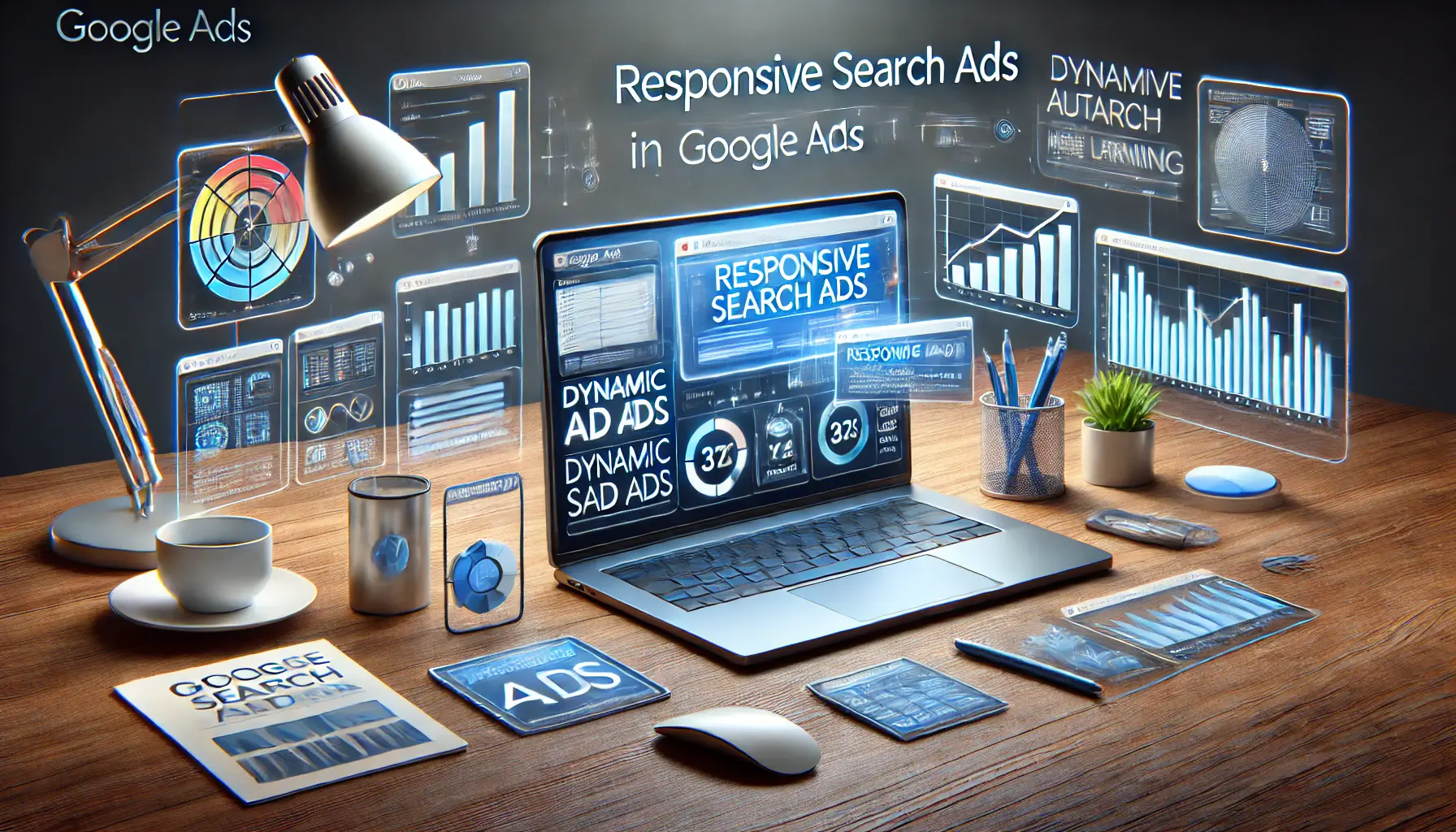
A visual illustration of Responsive Search Ads, showcasing the Google Ads platform’s dynamic and automated ad creation process.
Introduction to Responsive Search Ads
Responsive Search Ads were introduced by Google Ads with the aim of offering more dynamic and personalized ads.
Unlike other ad formats, in RSA you do not need to create several versions of an ad.
Instead, you can create up to 15 headlines and 4 descriptions, and Google will analyze the performance of these elements to select the best combinations based on real-time dataInformation that is available as soon as it is collected, without delays., making it easier for advertisers to reach their audiences.

A representation of how Responsive Search Ads work, highlighting Google’s algorithmic testing and optimization of multiple ad variations.
How Responsive Search Ads Work
The magic of Responsive Search Ads is in utilizing advanced machine learning algorithms developed by Google.
When you create Responsive Search Ads, you include multiple headlines and descriptions, and Google’s system takes care of the rest.
The algorithm keeps experimenting with combinations to find the most effective pairings, ensuring your ads stay relevant and perform well.
The more unique your headlines and descriptions, the better the chances of your ads standing out and catching the right customer’s attention.
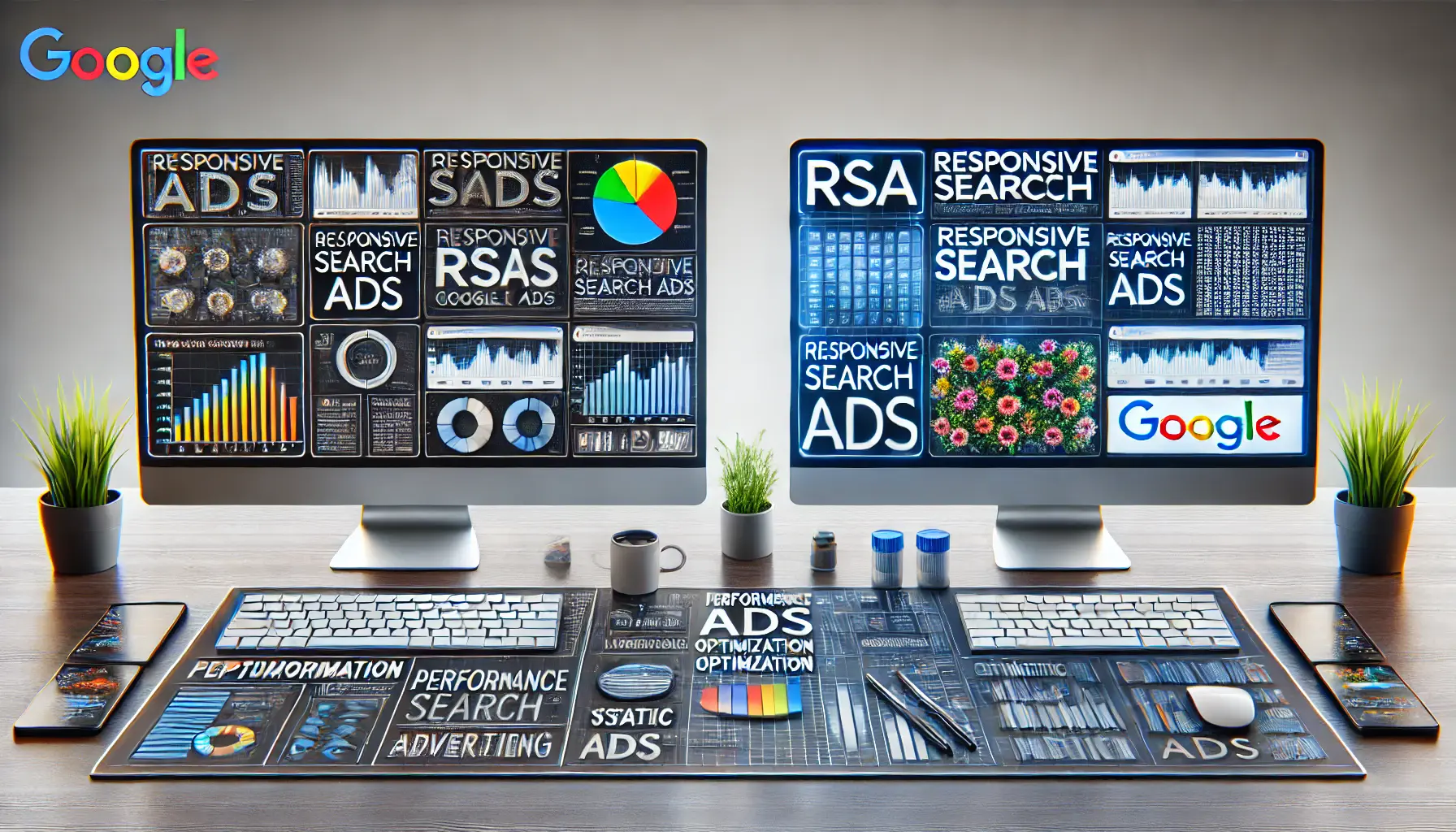
An illustration of the key differences between traditional static ads and Responsive Search Ads, showcasing the flexibility and optimization of RSAs.
Key Differences Between RSA and Traditional Ads
The major difference between Responsive Search Ads and traditional search ads is flexibility.
In traditional ads, you need to create one static version, but Responsive Search Ads allow you to provide multiple variations for Google to mix and match.
This makes RSA more adaptable to user intent and different search queries.
While traditional ads rely on a single message, RSA dynamically adjusts your ads for relevance based on user behavior, increasing engagement and click-through ratesThe ratio of users who click on a specific ad to the number of total users who view it..
- Multiple headlines and descriptions: In RSA, you can provide up to 15 headlines and 4 descriptions, while traditional ads are limited to just one version.
- Automated testing and optimization: Google automatically tests combinations and optimizes the best-performing ads, saving you time on manual A/B testing.
- Real-time relevance: RSA tailors ad copy to real-time user behavior, ensuring your ads are more relevant to each search query.
Responsive Search Ads dynamically adapt your ad combinations to user queries, optimizing performance through machine learning.

A depiction of the benefits of Responsive Search Ads, highlighting improved ad performance, automation, and flexibility in Google Ads.
The Benefits of Responsive Search Ads
In this fast-changing digital marketing world, Responsive Search Ads have become an essential tool to help advertisers improve campaign performance.
Coupled with Google’s machine learning, these ads provide a more adaptive and personalized ad experience.
Let’s take a closer look at the key benefits of incorporating Responsive Search Ads into your Google Ads strategy.
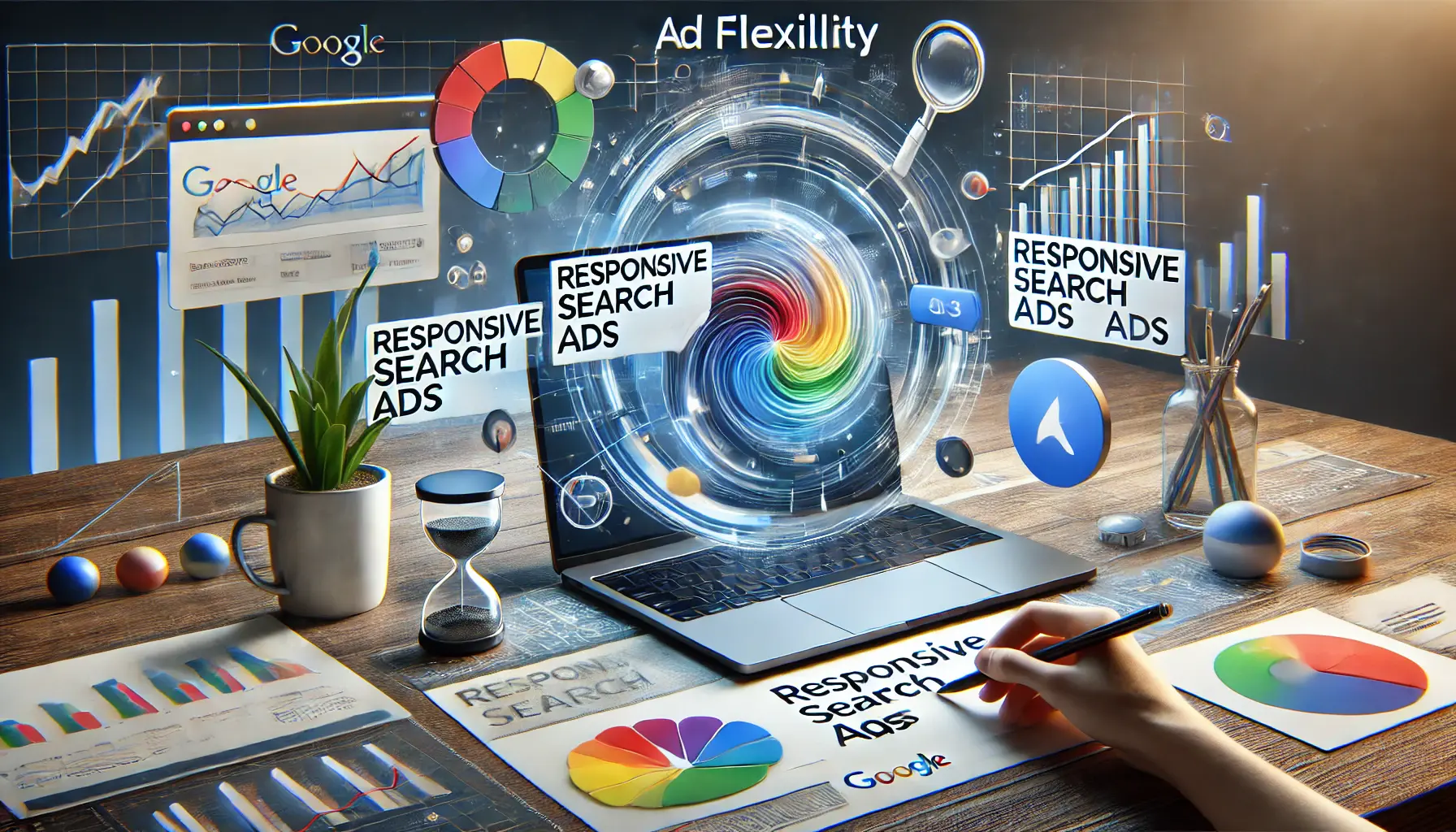
An illustration of the flexibility offered by Responsive Search Ads, showcasing dynamic ad variations and real-time optimization.
More Ad Flexibility
One of the biggest benefits of Responsive Search Ads is their flexibility.
Instead of relying on a single static ad, RSA allows you to create up to 15 headlines and 4 descriptions, which Google will mix and match to find the most relevant combination for each different search query.
This ensures your ads resonate with different audiences in different contexts, making your campaign more adaptable and agile.
With this feature, you can build ads for broader coverage, where targeted ad messages better match the search intent of your audience.
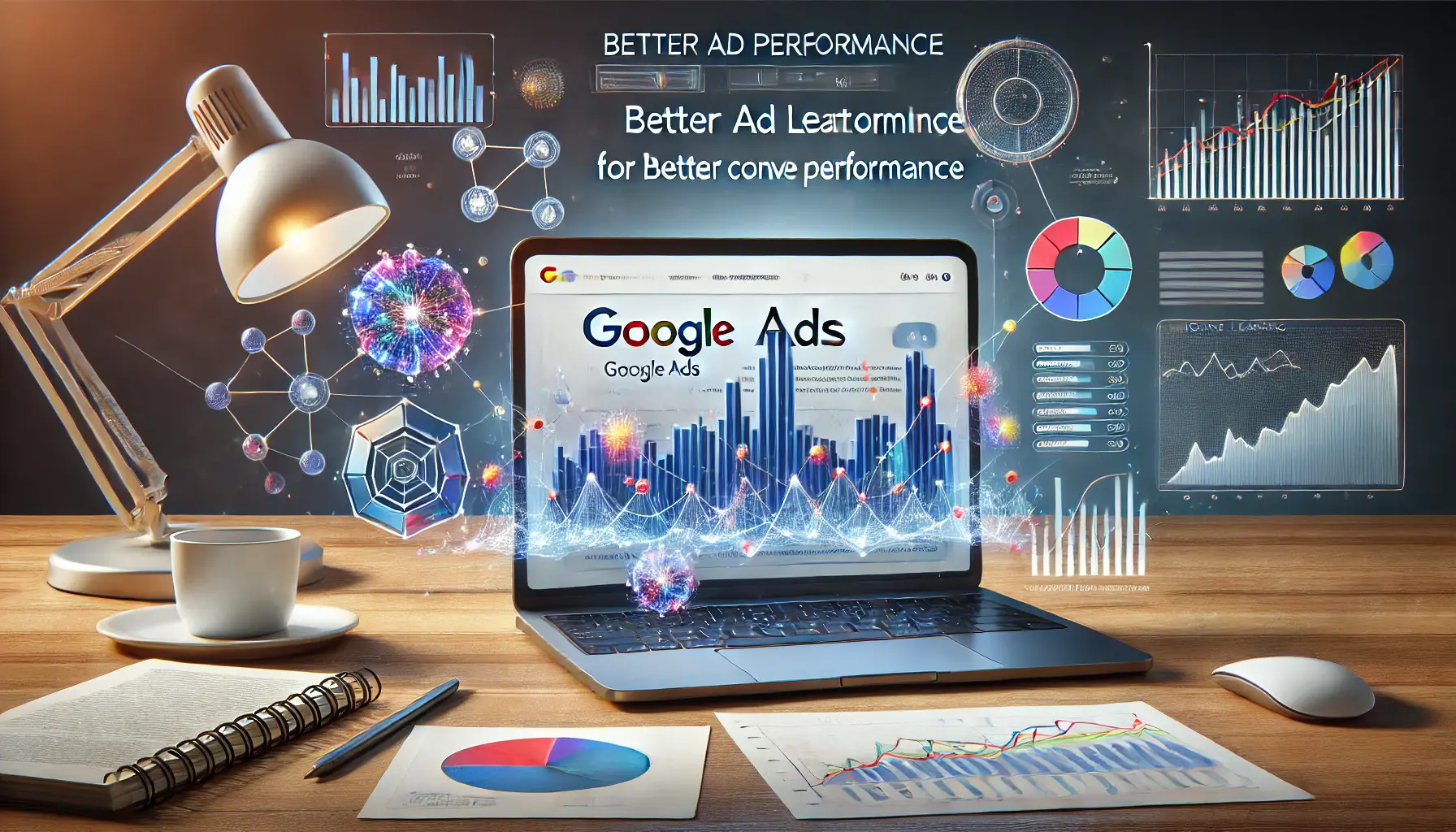
An illustration of how machine learning enhances ad performance, optimizing Responsive Search Ads in Google Ads for better results.
Better Performance through Machine Learning
Responsive Search Ads leverage Google’s machine learning to enhance performance.
By analyzing real-time data, Google’s algorithms determine which headlines and descriptions work best for each user segment.
This results in better ad performance over time, as the system continually optimizes your ad combinations.
Advertisers can expect improvements in click-through rates (CTR) and conversion ratesThe percentage of users who complete a desired action, like making a purchase, after clicking an ad., as the most effective ads are shown to the right audience at the right time.
- Improved CTR and conversion rates
- More accurate targeting based on real-time data
- Automatic optimization for better ad delivery

An illustration of enhanced reach and precise user targeting, showcasing how Responsive Search Ads in Google Ads can adapt to reach diverse audiences.
Enhanced Reach and User Targeting
Another significant benefit of Responsive Search Ads is their ability to expand your reach.
Google rotates different headline and description combinations, allowing your ads to cover a wider audience with a broader range of search queries.
This also enables more precise user targeting, as the algorithm identifies which ad combinations are most effective for specific user groups.
Over time, this level of advanced targeting leads to better quality engagements and a stronger return on ad spend.
Responsive Search Ads work especially well when combined with other audience targeting options, such as in-market audiencesAudiences actively researching or planning to purchase a product or service. or affinity audiencesGroups of users with interests or hobbies relevant to an advertiser’s product or service..
This combination allows advertisers to reach the right people while delivering the most relevant message.
- Greater reach due to dynamic combinations of ads
- Precise targeting thanks to machine learning
- Higher engagement and relevance for users
RSAs are game-changers because they offer flexibility in ad combinations, ensuring better engagement and performance.

An illustration of the process of writing effective Responsive Search Ads, highlighting the creation and optimization of ad components for better performance.
How to Write Effective Responsive Search Ads
The secret to writing Responsive Search Ads that drive great results is to have a well-thought-out strategy.
While Google’s machine learning will do much of the optimization for you, your success will be closely tied to how well you create the initial components—headlines, descriptions, and overall ad structure.
Here’s how you can create effective Responsive Search Ads that capture attention and drive conversions.

An illustration of the process of writing compelling ad copy, emphasizing creativity and the crafting of engaging headlines and descriptions.
Writing Compelling Ad Copy
The foundation of any effective ad is its copy, and Responsive Search Ads are no different.
Each headline and description needs to be clear, engaging, and related to your audience’s search intent.
Keep your headlines and descriptions concise without sacrificing clarity.
Be sure to work in your selling points and emphasize the benefit of what you’re offering.
Here are a few suggestions to keep in mind:
- Ensure language is action-oriented, prompting users to take the next step, such as ‘Buy Now,’ ‘Learn More,’ or ‘Get Started.’
- Avoid a spammy tone; include your primary keyword target organically, such as ‘Responsive Search Ads’ or related terms, in both headlines and descriptions to show ad relevance.
- Lead with value-adds like discounts, trials, or promotions for the customer.
- Avoid repetition. Since Google rotates headlines and descriptions, make each variation unique to prevent redundancy.

An illustration of the best practices for writing headlines and descriptions in Google Ads, highlighting creativity, optimization, and performance.
Best Practices for Headlines and Descriptions
Since Responsive Search Ads allow you to use up to 15 headlines and 4 descriptions, make full use of this feature.
With a variety of ad copy, Google can test different combinations and identify what works best.
When writing headlines, consider the following best practices:
- Include at least one keyword-relevant headline to improve ad relevance.
- Match headlines with the user’s search intent, either addressing pain points or offering solutions.
- Use dynamic language and power words like ‘exclusive,’ ‘instant,’ or ‘guaranteed’ to make your ads more compelling.
- Test different styles—while short, punchy headlines work well, longer, more descriptive headlines can also capture interest.
As for descriptions, focus on continuing the story or message your headlines have already conveyed.
Descriptions should emphasize the features, benefits, and unique selling propositions of your product or service.
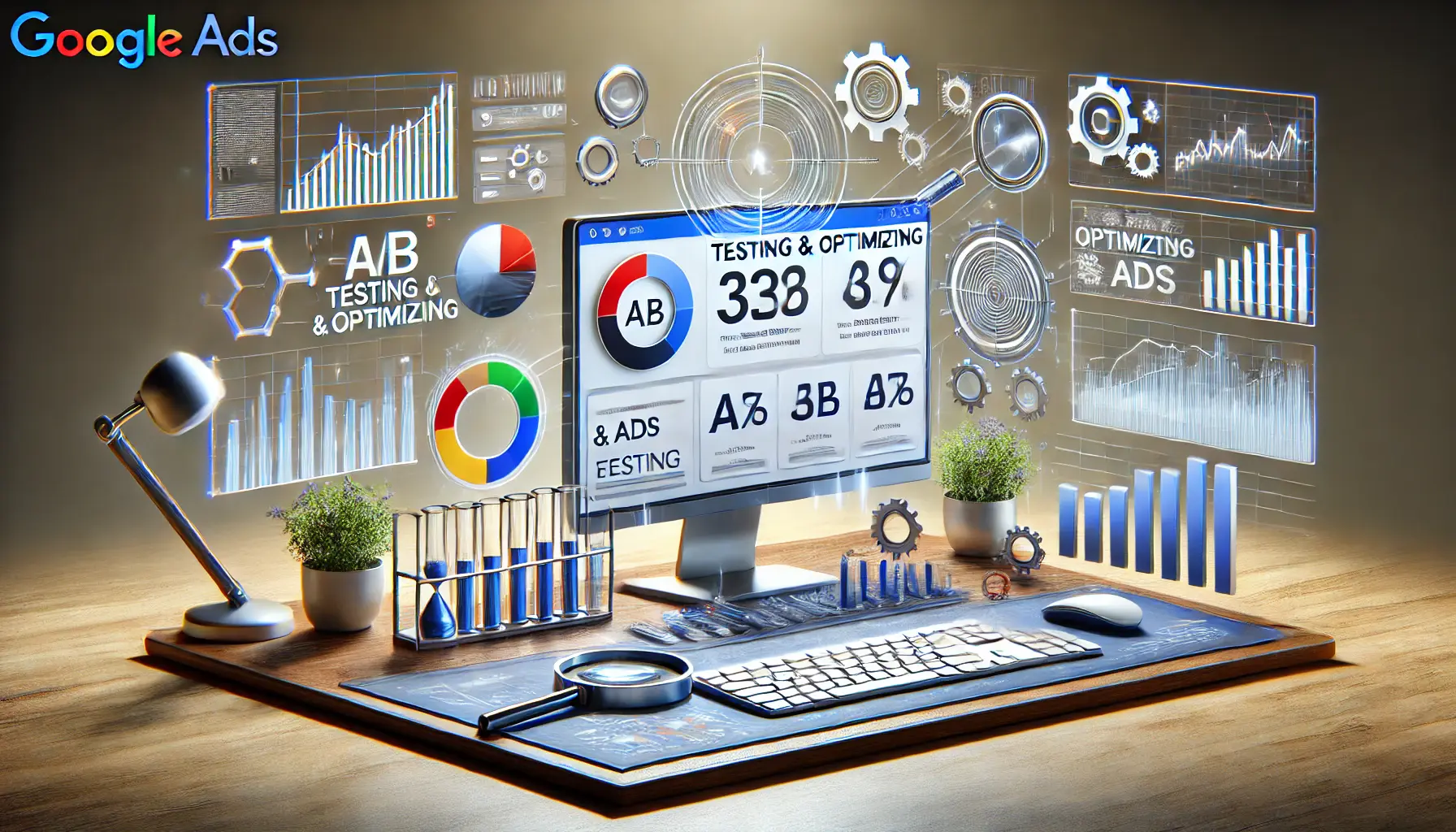
An illustration of the process of testing and optimizing ads, highlighting the tools used in Google Ads to improve performance through continuous analysis.
Testing and Optimizing Your Ads
One of the advantages of Responsive Search Ads is that you can constantly test and refine your ads based on performance data.
Google’s machine learning will automatically optimize combinations, but it’s essential to monitor how this is working and make adjustments as necessary.
Here are some effective ways to test and optimize your RSA campaigns:
- Periodically check performance reports from Google Ads to understand which combinations yield the most clicks and conversions.
- Rotate new headlines and descriptions periodically to keep ads fresh and test different approaches.
- Use A/B testing for different components like calls to action or value propositions to determine which variation converts best.
- Analyze which ad combinations resonate best with different audience segments and adjust your targeting accordingly.
By following these steps and regularly refining your Responsive Search Ads, you’ll be able to maximize campaign performance and ensure your ads stay relevant and effective over time.
Effective RSA ad copywriting requires clarity, creativity, and relevance to user intent. Each headline should capture attention and drive conversions.

An illustration of the challenges and limitations of Responsive Search Ads, highlighting obstacles like disapproved ads and performance inconsistencies.
Challenges and Limitations of Responsive Search Ads
Responsive Search Ads come with a great deal of benefits, but they are not without their challenges.
As with all advertising tools, there are certain limitations that advertisers need to be mindful of to maximize the potential of their campaigns.
Understanding these limitations will help in developing more effective strategies and avoiding potential pitfalls.
Let’s take a closer look at the challenges associated with Responsive Search Ads.

An illustration of the ad approval process in Google Ads, highlighting challenges like delays, disapprovals, and review progress.
Ad Approval Process
One of the most common challenges experienced by advertisers using Responsive Search Ads is the ad approval process.
Since RSAs allow multiple headlines and descriptions, each variation must be approved by Google’s system.
This can lead to delays if any component violates Google’s ad policies.
If one headline or description is disapproved, it can negatively affect the overall performance of your ad campaign.
Advertisers need to be cautious and ensure all elements meet Google’s strict advertising guidelines to avoid disruptions.
An illustration of performance tracking and reporting issues in Google Ads, highlighting the challenges of incomplete data and difficulties in analyzing performance.
Performance Tracking and Reporting Issues
Another limitation of Responsive Search Ads is the complexity in tracking and reporting performance data.
Although Google’s system auto-optimizes the ads, it does not always provide detailed reporting on which specific headline and description combinations are performing best.
This can make it more challenging for advertisers to fully understand what works and what doesn’t.
To work around this, advertisers should conduct periodic reviews of performance reports and adjust strategies based on broader trends rather than focusing on individual combinations.
- Limited visibility at an individual ad combination level
- Difficulty in identifying the best-performing variations
- Requires additional manual analysis to understand broader trends

An illustration of the limited control over displayed ad combinations in Google Ads, symbolizing the challenge of not being able to fully manage which ad versions are shown.
Limited Control Over Displayed Combinations
One of the defining features of Responsive Search Ads is the automated combination of headlines and descriptions.
However, this automation limits the advertiser’s control over which combinations are shown to users.
While Google’s algorithm determines the best-performing combinations, there is no guarantee that the advertiser’s preferred message will always be displayed.
This can be frustrating, especially for campaigns that rely on a specific brand message or tone.
Although automation can increase relevance and flexibility, it can also result in ad combinations that don’t align perfectly with your intended messaging.
Advertisers need to strike a balance between providing enough variety for Google’s machine learning and maintaining consistency in brand voice across all combinations.
- Reduced control over which combinations are shown
- Potential for inconsistent messaging
- Challenges in maintaining brand voice consistency
Advertisers must be mindful of limited control over ad combinations and potential approval delays.

An illustration representing the future of Responsive Search Ads, highlighting the role of advanced technologies like AI and automation in shaping the future of digital marketing.
The Future of Responsive Search Ads in Digital Marketing
As digital marketing continues to develop and evolve, Responsive Search Ads (RSAs) are expected to play an increasingly essential role in advertising.
Automation, combined with machine learning and personalized ad experiences, adds to the power of RSAs for advertisers.
Current trends suggest that these capabilities will continue to grow.
Let’s explore how RSAs are set to revolutionize the future of digital marketing.

An illustration representing the integration of AI and machine learning in Google Ads, showing how these technologies enhance ad performance and decision-making.
Integration with AI and Machine Learning
The role of AI and machine learning is becoming critical in digital marketing, and Responsive Search Ads are perfect examples of how these technologies are transforming advertising.
In the future, Google’s AI algorithms will be further developed, allowing RSAs to deliver more personalized and targeted ads based on user behavior and intent.
As AI continues to learn from user interactions, advertisers will experience better ad execution with less manual effort, improving return on ad spend (ROAS).
Similarly, RSAs will integrate more seamlessly with advanced AI tools, enabling advertisers to access predictive analytics and deeper consumer insights.
This will allow for more precise targeting and immediate adjustments to strategies based on data-driven insights.

An illustration of how digital marketing adapts to changing consumer behavior, with symbols representing mobile usage, voice search, and real-time data trends.
Adapting to Changing Consumer Behavior
Consumer behavior is constantly shifting due to increasing mobile usage and voice search.
Users now demand more personalized, real-time content that is highly relevant.
Responsive Search Ads are uniquely positioned to meet this demand by dynamically serving the best ad combinations based on a user’s specific query and behavior.
As more consumers rely on voice search and mobile-first browsing, RSAs will become even more crucial in adapting to these changing trends.
Advertisers who embrace these changes and optimize Responsive Search Ads for mobile and voice search will be better positioned to capture a larger share of the market.

An illustration of the next generation of search ads, featuring AI-driven technologies, predictive analytics, and multimedia content in a futuristic digital marketing environment.
Predictions for the Next Generation of Search Ads
The future of Responsive Search Ads looks promising, with several key developments on the horizon.
Here are some predictions for how RSAs will continue to evolve:
- Advertisers will have increased influence over how their ads are displayed through more granular control of ad combinations, while still benefiting from machine learning optimizations.
- RSAs will see increased integration with other Google tools, such as Google Analytics and Google Marketing Platform, providing deeper insights into consumer journeys and ad performance.
- Enhanced support for multimedia elements within RSAs, such as dynamic video and image content, will enable more engaging ad experiences.
- Automation in audience targeting will become even more advanced, allowing AI to automatically identify high-intent users and serve them the most relevant ads.
As Responsive Search Ads continue to evolve, advertisers will need to stay ahead of the curve by embracing new features and adapting their strategies to maximize effectiveness.
AI integration in RSAs will become more advanced, offering deeper insights and more personalized ads.

An illustration of the impact of Responsive Search Ads on modern advertising, highlighting their transformative role in improving performance and reach.
Impact of Responsive Search Ads on Modern Advertising
As we explored in this article, Responsive Search Ads (RSAs) are a significant revolution in digital marketing, driven by automation, machine learning, and dynamic content delivery.
RSAs have opened new doors for advertisers by offering more flexibility, making ads more personalized, and improving overall ad performance.
However, like any tool, there are both benefits and challenges that must be considered when incorporating RSAs into your marketing mix.
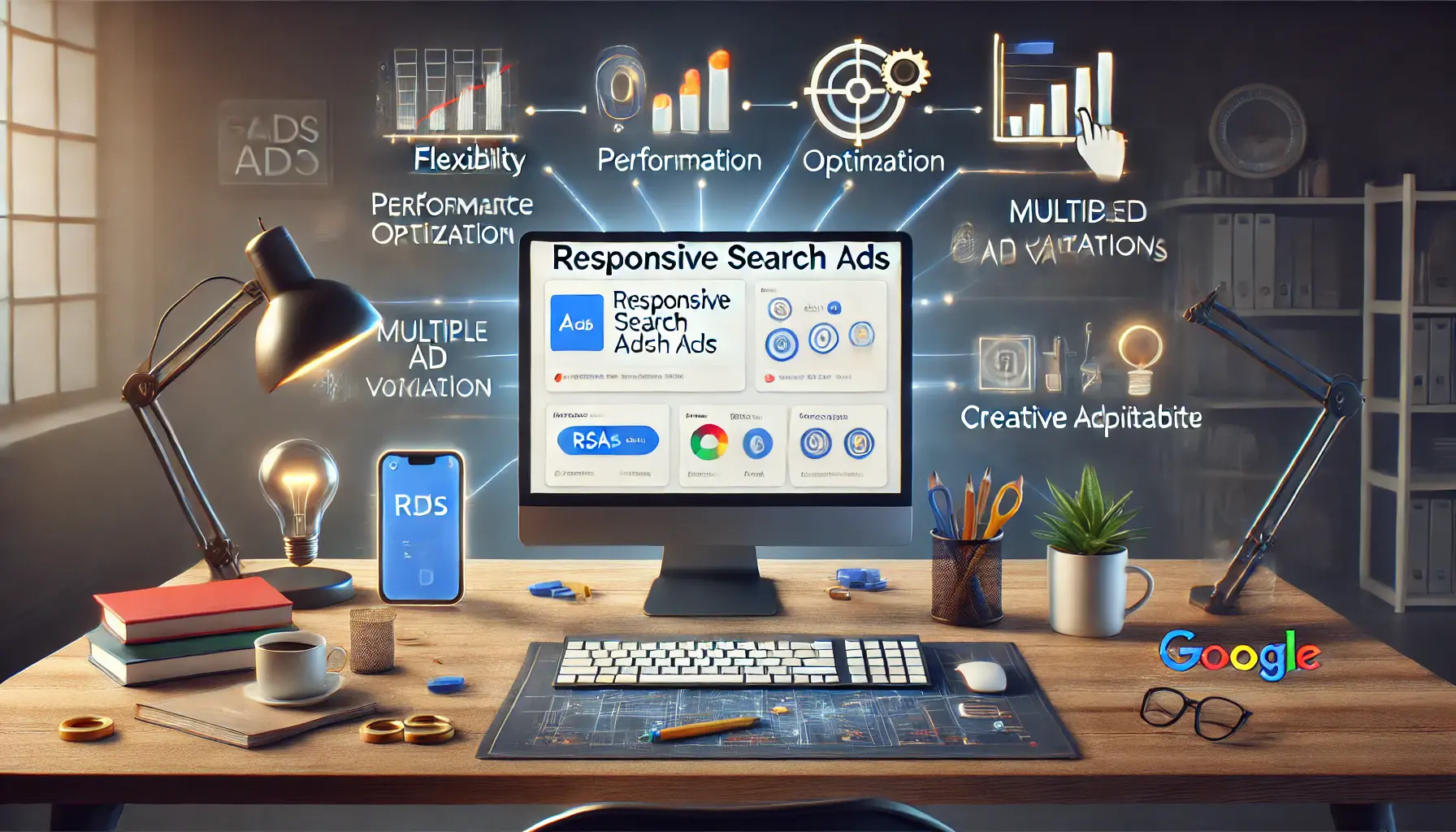
An illustration of the main advantages of Responsive Search Ads, highlighting their flexibility, automation, and performance optimization in digital marketing.
Main Advantages of Responsive Search Ads
Responsive Search Ads offer several key advantages that enhance advertising campaigns:
- Flexibility: The ability to create multiple headlines and descriptions provides an excellent opportunity to reach different audiences and search queries.
- Performance Optimization: Google’s machine learning algorithms ensure that the most effective ad combinations are served, improving engagement and click-through rates (CTR).
- Increased Reach: RSAs expand reach by adjusting to user behavior, enabling advertisers to connect with a wider variety of potential customers.
By taking advantage of these benefits, advertisers can create more engaging, relevant, and effective ad campaigns, resulting in a higher return on investment (ROIReturn on Investment; a measure of the profitability of an ad or campaign relative to its cost.).

An illustration of the challenges and considerations in using Responsive Search Ads, highlighting issues like ad disapproval, limited control, and data tracking challenges.
Challenges and Considerations
While the potential of Responsive Search Ads is impressive, there are several limitations advertisers need to be aware of:
- Limited Control: RSAs are automated, meaning advertisers have less control over which specific ad combinations are shown, which can sometimes lead to inconsistent messaging.
- Ad Approval Delays: With multiple headlines and descriptions requiring approval, there can be delays if any elements violate Google’s advertising policies.
- Data Transparency: RSAs provide limited visibility into which specific combinations perform best, making it challenging for advertisers to analyze real-time performance. Instead, they must focus on broader trends.

An illustration of the future of Responsive Search Ads in digital marketing, highlighting innovations like AI optimization, automation, and enhanced targeting.
The Future of RSAs in Digital Marketing
With continuous improvements in machine learning and AI, Responsive Search Ads will become even more efficient at delivering personalized, high-performing ads.
In the future, AI tools, predictive analytics, and advanced targeting methods will further enhance advertisers’ ability to reach the right audience at the right time.
Additionally, RSAs will play a key role in adapting to changing consumer behavior, especially with the growing importance of mobile and voice search.
As these trends continue to evolve, RSAs will help keep ad campaigns relevant and effective.
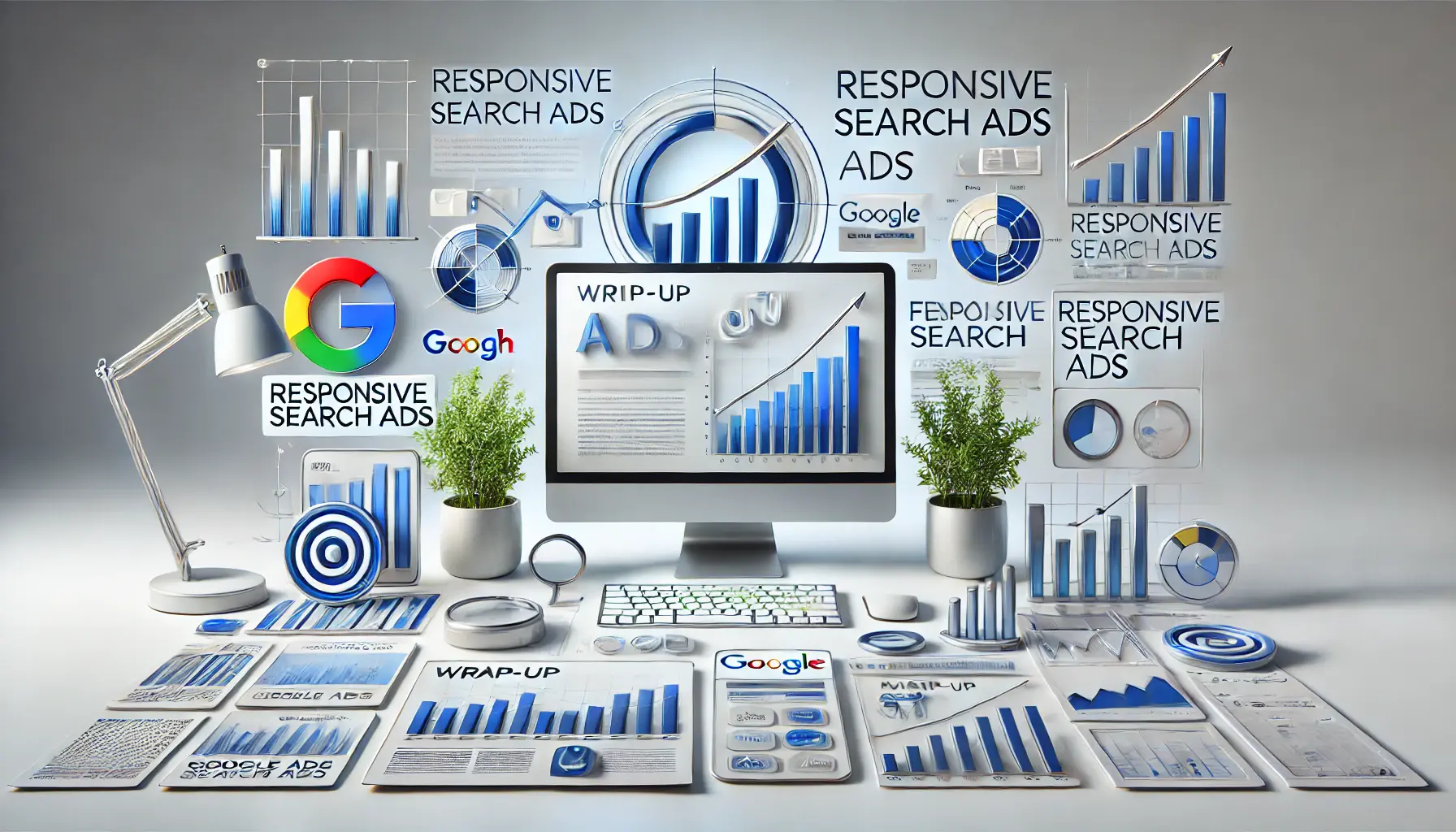
An illustration representing the conclusion of a digital marketing strategy using Responsive Search Ads, highlighting success and growth through final reports and analytics.
Conclusion
Responsive Search Ads have transformed the digital marketing landscape by introducing greater dynamism and automation in ad creation.
They save time for advertisers, reach wider audiences, and guarantee better performance by leveraging the power of machine learning.
As RSAs continue to evolve, staying informed about new developments and refining your strategies will be crucial to harnessing the full benefits of this ad format.
By embracing Responsive Search Ads and understanding both their strengths and limitations, advertisers can unlock new opportunities for growth, engagement, and success in today’s ever-evolving digital marketing landscape.
RSAs offer unmatched flexibility and performance optimization, making them a critical tool for modern advertisers.

An illustration of responsiveness to questions about Responsive Search Ads, highlighting customer engagement and interaction in addressing concerns dynamically.
Your campaigns can be managed by an agency specialized in Google Ads, check out our service page.
Responsiveness to Questions About Responsive Search Ads
Below are several common questions and brief answers regarding Responsive Search Ads (RSAs) and their benefits.
Although RSAs are driving significant momentum among advertisers, there are often questions associated with them.
Unlike traditional ads, which are static, Responsive Search Ads allow you to create multiple variations of headlines and descriptions.
Google’s algorithm dynamically adjusts the ad combinations, improving relevance and performance based on user intent.
By using multiple headlines, Responsive Search Ads can adapt to different search queries, increasing the chances of resonating with diverse audiences.
Over time, Google’s algorithm identifies the best-performing combinations, improving engagement and conversion rates.
Though Responsive Search Ads are automated, advertisers have limited control over which specific ad combinations are displayed.
Google’s algorithm determines the best-performing variations, but you can guide the content by selecting appropriate headlines and descriptions.
You can measure the performance of Responsive Search Ads by tracking broader performance trends through metrics such as click-through rates (CTR) and conversion data.
Google Ads provides performance reports, but these do not offer a detailed breakdown of specific combinations.














